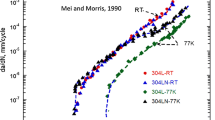Abstract
Effects of various heat treatment processes, including Q/L-T, Q/H-T, Q/L-T + Ti-nitriding, Q/H-T + Ti-nitriding, and Q/CT/H-T on the S-N fatigue behavior of SKD11 steel were investigated. Ti-nitriding is a modified nitriding process that entails a small addition of approximately 2 g to 20 g of electrolyzed fine, metallic titanium in a salt bath. In the present work, depending on the applied stress and surface conditions, different crack initiators were operative, resulting in three types of crack initiation. Multi-site crack initiation around the specimen surface, observed only for the Ti-nitrided specimens at a high stress range, decreased the resistance to S-N fatigue by reducing the crack initiation cycles, Ni. At low and intermediate stress ranges, the cracked carbide particles located near the surface or internally served as crack initiators for all the specimens, regardless of whether Ti-nitriding was applied, resulting in similar resistances to S-N fatigue. Different heat treatment parameters, such as tempering temperature and cryogenic treatment, did not affect the fatigue behavior of SKD11 steel to any considerable degree. The fatigue behavior of SKD11 specimens with different heat and surface treatment conditions is discussed based on micrographic and fractographic observations.
Similar content being viewed by others
References
Y. C Lee, F. K Chen, J. Mater. Proc. Tech. 113, 539 (2001).
F. Kenzo, Y. Yoshihiko, Y. Daien, T. Nobuhiro, and O. Kanji, Metall. Mater. Trans. A 35, 1289 (2004).
G. H. Farrahi, and H. Ghadbeigi, J. Mater. Proc. Tech. 174, 318 (2006).
S. Zhirafar, A. Rezaeian M. Pugh, J. Mater. Proc. Tech. 186, 298 (2007).
G. Krauss, Steels: Heat Treatment and Processing Principles, p. 205–212, ASM International, Materials Park, Ohio (1990).
M. Fanju, T Kohsuke, and S. Hideaki, Scripta mater. 31, 865 (1994).
J. Y. Huang, Y. T. Zhu, X. Z. Liao, I. J. Beyerlein, M. A. Bourke, and T. E. Mitchell, Mater. Sci. Eng. A 339, 241 (2003).
D. A. Canonico, Heat Treating, 9 th ed., Vol. 4, p. 3–5, ASM International, USA (1981).
T. Bell and S. Y. Lee, Gaseous Atmospheric Nitrocarburising, Heat Treatment’ 73, Vol. 163, p. 99–107, The Metals Society, London (1975).
K. Genel, M. Demikol, and M. Capa, Mater. Sci. Eng. A 279, 207 (2000).
F. Ashrafizadeh, Surf. Coat. Tech. 174–175, 1196 (2003).
J. Ko, US Patent Pub. No.20070243398 (2007).
I. Lee, J. Kor. Inst. Met. & Mater. 46, 357 (2008).
P. Lukás, Fatigue and Fracture, 4 th ed., Vol. 19, p. 96–97, ASM International, USA (2005).
G. Magudesswaran, Met. Mater. Int. 14, 523 (2008).
Author information
Authors and Affiliations
Corresponding author
Rights and permissions
About this article
Cite this article
Jin, S., Kim, S., Lee, Y. et al. Effect of various heat and surface treatment conditions on the fatigue behavior of SKD11 steel. Met. Mater. Int. 15, 917–923 (2009). https://doi.org/10.1007/s12540-009-0917-7
Received:
Accepted:
Published:
Issue Date:
DOI: https://doi.org/10.1007/s12540-009-0917-7




